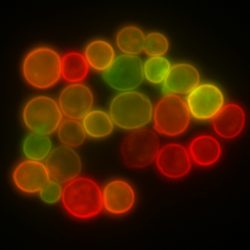Yesterday, Bwog Science Editor Alex Tang attended “Translation of the Genetic Code: Brakes Included,” a Department of Biological Sciences seminar hosted by Dr. Elizabeth Grayhack (University of Rochester). Here, he tells us about the central dogma of molecular biology, and recent efforts to analyze some of its surprising inefficiencies.
Molecular biology is a fascinating, complex, and insanely messy field of science—a hodgepodge of molecules and pathways. It’s possible, however, to simplify this entire field into what is known as the Central Dogma of Molecular Biology. Here it is: life is made possible because DNA is transcribed into RNA, which is then translated into protein.
Everyone knows about DNA, the genetic information that gives us all of our physical (and some mental) traits. All of our cells keep DNA in the nucleus, a central, enclosed cell command center. The DNA provides all the information needed to make proteins, which are the molecules that essentially do all the work to maintain life. DNA is first transcribed into RNA, a working copy that travels from the nucleus to the cytoplasm, thus preserving the valuable DNA from wear-and-tear. Proteins are translated (biological lingo for created) from RNA in the cytoplasm, outside of the nucleus.
- one yeast, two yeast, red yeast, green yeast
Every protein is made up of hundreds or thousands of amino acids. Most living beings have a total of 20 different amino acids. During translation, RNA is “read” by ribosomes, which slide along the the strand of RNA like moving beads on a string. Ribosomes read RNA in codons (three nucleotides at a time). Each codon corresponds to an amino acid, which is added one after the other in the order of the codons on the RNA. Since there are 4 different RNA nucleotides (adenine, guanine, cytosine, and uracil), there are 64 possible codons (4x4x4). However, since there are only 20 amino acids, and each of the 64 codons corresponds to an amino acid, we know that there is a redundancy in the genetic code. In other words, some amino acids may be coded by multiple codons.
What’s interesting is that for amino acids that have redundant codons, certain codons are used more than others. This has widespread implications, for example in cancer research. Certain cancer metastases are associated with the prevalence of specific codons. In a specific experiment described by Dr. Grayhack, organisms that were given different tRNAs for the same amino acid had significantly different rates of cancer growth, demonstrating a causative relationship between specific codon usage and cancer growth. Many organisms have favored codons for a specific amino acid, meaning that certain codons are used more than others to code for the synonymous amino acid. For example, codons CGT, CGC, CGA, CGG, AGA, and AGG all code for the arginine amino acid, but CGA is rarely used. It has been demonstrated that suboptimal codons (such as CGA) result in slow, inefficient translation.
Dr. Grayhack discussed her own research, which focuses on elucidating the identities and properties of codons that impair translation. Her team first worked on identifying the codons that were suboptimal. To do so, she looked at genetically engineered strains of yeast that had adjacent RFP and GFP genes (RFP allows the cell to glow red, while GFP allows the cell to glow green). Using this yeast, her team created different strains that each had one predominant type of redundant codon in the GFP gene. If a specific redundant codon was inhibitory, or resulted in inefficient translation as with CGA for arginine, then the yeast cell would glow less green, and appear more red. By comparing the red-to-green visual ratio of each strain using flow cytometry, her team identified various inhibitory codons. What’s more, they identified the phenomena of codon pair inhibition, in which inefficient codons that were engineered next to each other enhanced the effect of inhibition and slowed translation even further. Dr. Grayhack’s team identified 17 such inhibitory codon pairs.
Dr. Grayhack then introduced her model of how these inhibitory codon pairs affect translation. She hypothesized that ribosomes, when moving along an RNA strand to translate protein, slow down when encountering inefficient codons. As a result, at inefficient codon pairs, ribosomes may stall, and ribosomes further down the line will collide with the stalled ribosome, almost like a rear end car accident at a stop light. This ribosome collision induces the degradation of the RNA itself, as well as the growing protein peptide.
Inhibitory codon pairs seem to be functionally important. When analyzing five related yet distinct yeast species, Grayhack found that inhibitory codon pairs were much more likely to be conserved than most other codons (above three standard deviations worth!). This means that somehow, individual yeast cells without these inhibitory codon pairs were less likely to survive or to pass on those traits to their progeny. This tells us that the inhibitory codon pairs must have some significant function, which we still have yet to decode. It appears that we have lots more to figure out about the Central Dogma, and its widespread implications for biomedical solutions.
Columbia’s Department of Biological Sciences normally hosts seminars weekly, usually on Mondays at noon. Seminars are open to all students.
Yeast via Wikimedia Commons


 0 Comments
0 Comments
